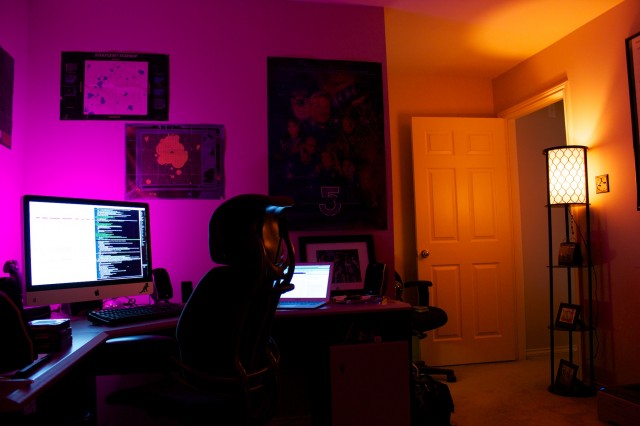
I owe Ars alum and Wirecutter Editor-in-Chief Jacqui Cheng a debt of gratitude for forwarding me an e-mail from Philips PR representatives back in October 2012. Philips had approached Jacqui about reviewing the just-launched devices, but Jacqui’s schedule at the time was filled to bursting with Apple topics, and so I volunteered to step up and play with the fancy wirelessly controlled color-changing lights—and I fell in love with them.
In spite of their high price—$199.95 for a starter kit with three bulbs and $59 for each additional bulb after that—it wasn’t long before I found my house festooned with dozens of the things, scattered through every room. My wife and I wake up to them in the bedroom at 6:30am, and the set in my office shifts tones throughout the day, brightening to task lighting levels at mid-morning and shifting to a golden sunset color at five o’clock when it’s time to start wrapping up work. I am an unabashed fan, and after two years it’s impossible to imagine working at home without them.
Hue isn’t the only fancy wirelessly controlled light—there’s Lifx, Lümen, Insteon bulbs, and others as well. They all form a subcategory in the Internet of Things pantheon called "connected lighting." But though competitors are multiplying, Hue was the first color-changing app-controlled system to make it to market, and thanks to an open and easily accessible API it remains one of the most feature-complete. Out of all of them, it’s the one I’ve chosen to live with, and so far it’s been a rewarding product to own.
Hue as a product can be traced back to a fellow named George Yianni, Head of Technology for Connected Lighting at Philips. Yianni was the project leader tasked with guiding the Hue project through conception to market, and as we’ll see, developing a product like Hue inside of a large global company like Philips took a bit of process hacking.
Skunkworks, but for lightbulbs

Hue was born out of an internal effort at Philips to see what would happen if the company added connectivity of some sort to standard light bulbs. With other technology companies like Google making lots and lots of noise about the "Internet of Things"—the oft-misrepresented and misunderstood concept of a world full of connected devices all performing their functions while communicating with each other—Philips management wanted a piece of that pie. The company saw itself as a leader in lighting technology and wanted to use that leadership to stake a claim in the "Internet of Things" frontier.
The company took a page from aerospace giant Lockheed’s famous "Skunk Works" Advanced Development Project division, assembling a small group of engineers operating semi-independently and empowered to design the product quickly and without a lot of bureaucratic interference and second-guessing.
Yianni led that group, and the Hue design crystalized around the idea of not just making a cool app-controlled light, but of actually looking at what normal people would need and want out of wireless lights.
In order to figure that out, the team made a few assumptions and then quickly hacked together four different prototype sets of lights and apps to test four distinct use cases, to see which would appeal the most to potential customers. The first was using colored lighting to decorate a home; next was linking lighting to data streams, so lights blink or change color when you get new e-mails, for example; then came using light colors to influence mood and other biological factors; and the last was using lights to "scare the ghosts away"—making it so that users never have to come home to a dark house.

After running through several testing iterations of each use case with different groups of consumers, it quickly became clear that customers wanted to do not just some of those things, but all of those things. In-home placement tests showed that people certainly liked having tunable white lights, but adding color-changing capabilities pushed consumer reactions through the roof. Being able to use the lights to decorate homes with color created a personal connection, and that quickly became a core feature.
The fast Skunk Works-style development model meant that Hue evolved from concept to store shelves in less than a year—agility almost unheard of in a company like Philips.
We are Hue
According to Yianni, the launch "totally surpassed all expectations." Hue kits were made available primarily through Apple stores, with Philips positioning Hue as a premium lifestyle type of product and with a premium price to match; even so, the entire allocation was sold out after the launch weekend.
The real value of Hue lights isn’t what they do out of the box, although Yianni’s team has spent considerable effort in bundling functionality into the lights. Rather, it’s in what the bulbs can be made to do. Rather than shackling the lights to a closed API so that only Philips-approved apps and controllers could command them, Yianni and his team had the foresight to create the Hue system with an open API and SDK. Anyone with even a modicum of programming ability—even someone like me!—can easily knock together a simple set of scripts or an application to change the Hue lights’ states, or tie their system in with something like IFTTT to give it a life of its own.
Given many companies’ total aversion to the perceived liabilities that potentially come with allowing the world at large to poke at their products, Hue’s openness is refreshing, and a bit surprising. I asked Yianni what it was like to attempt to get approval to design the product with this level of openness, and his response was awesome. "That was something we decided we were going to do and we just did it," he replied after a brief pause, "and ask forgiveness later. But the take-up and positive response from that was so good, that I think we proved to the rest of Philips that this is the way to go."
Yianni went on to explain that the small focused development effort was directly responsible for enabling that decision. "It’s not something we would have been able to do had we not had that small-startup-inside-big-company mentality… if you want your product to be successful, to live and grow on its own, you make it open, and people will come up with amazing ways of using them."
Dat app
If I have any real complaints about the Hue system—aside from inevitably grousing over its price—it’s the Hue app. Although much improved from its initial bare-bones functionality, it still doesn’t quite offer the level of customization and functionality that I’m looking for. On the other hand, I’m probably not a typical Hue consumer.
"We learned a lot in building the app," says Yianni, "mainly that everyone is going to want something different!" Philips has focused a lot of effort into encouraging users to interact with the lights in a holistic fashion—addressing them not as individual lights to turn on and off, but as whole-room canvases to be adjusted to fit moods and scenes. It is, unfortunately, a method of interaction that is squarely at odds with how a lot of geeks want to approach connected lighting.
Fortunately, there are plenty of alternatives. The only times I’ve invoked the official Hue app over the past year has been to install Hue software updates; the fact that the API is publicly available means that almost all of my interaction with my lightbulbs has been via cron jobs and the command line. Which actually sounds a little mental when I re-read that sentence, but hey, that’s just the kind of dork I am. Command line interaction with lightbulbs appeals to me.
(And, of course, you can still flip the lights on and off with a regular old standard light switch—they’ll behave like normal lights in that case, coming on to a standard white temperature.)
Securing your bulbs
The ugly side of wirelessly networked lightbulbs is that there will be security holes—it’s an unavoidable outcome any time a device gains the ability to be commanded remotely. We’ve written about these kinds of vulnerabilities in the past—including vulnerabilities that specifically target Philips Hue—and Yianni is aware that there’s a line to be walked between making the system easy to use and keeping users secure.
There are two potential avenues to gain remote control of Hue lights: via the Internet, or locally. Yianni assured Ars that the Hue design is safe from compromise via the Internet, which at least so far appears to be true—even the previous big vulnerability relied on a user’s local computer being infected with a piece of drive-by malware.
In order to issue commands to the lights, an issuing device or computer must be recognized by the Hue hub. That recognition is granted by requiring the user to physically press a button on the Hue hub when a new device attempts to send API commands; without that button press to register the new device, commands from it will be ignored. So, remote commanding Hue bulbs either requires physical access to the hub, or a compromise of an already-recognized device.
Even after that, though, the Hue bulbs don’t communicate with Wi-Fi—the system uses the Zigbee Light Link protocol. So compromising a Hue system wouldn’t necessarily get you access to a user’s home network—you’d be able to turn their lights on and off (slowly, since there are rate limits on API commands), but not much else.
Lux and friends
The next steps are a little hazy—because Philips is entering the mandatory quiet period prior to its quarterly earnings announcements, Yianni wasn’t able to give me too many details on where the Hue ecosystem might look during years three and four. However, the next set of Hue bulbs are already available—they’re called Hue Lux, and they’re a more basic type of bulb without the fancy color-changing ability. The Lux color temperature is fixed at 2700K ("warm white," the company describes it), but other than that it’s just like a regular Hue bulb.

In fact, it’s actually a little brighter—Philips lists the Lux’s max output at 750 lumens, compared to the standard Hue bulb output of 600 lumens. The Lux lights are sold in a starter pack of two with a hub for $99, with individual bulbs coming in at $29 (versus the full Hue starter kit for $199 and individual bulbs for $59). Currently the Lux bulbs fit the standard "lightbulb" form factor, with E27 screwcaps, but Yianni hinted that in the near future we’ll likely see lower-cost Lux versions of most of all of the rest of the Hue line.
And Yianni is also impressed and delighted with the ways that Hue users are—as much as I hate to use the marketing word—engaging with their lights. Yianni gave examples like people configuring Hue systems to flash or change color when their favorite sports teams score goals, or even, fascinatingly, coupling Hue to a heartrate monitor and using the lights’ pulsing as a form of biofeedback control.
As for me, I’ll likely keep buying the things until almost all of the lights in the house are Hue or Hue Lux, one way or another. If the bulbs last as long as they’re supposed to (15,000 hours for Hue and 25,000 hours for Hue Lux), it seems like a good way for a crazy tech geek like to spend his money.
reader comments
64